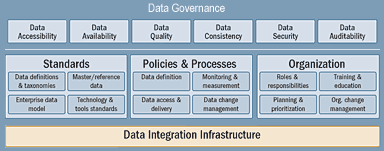LESSON - How to Launch a Data Governance Program: Practical Guidelines for Technology Implementers
By Judy Ko, Director, Enterprise Marketing, Informatica Corporation
Organizations are recognizing the value of data as a strategic business asset—one to be carefully developed and managed. However, many have not yet evolved their processes, policies, and infrastructure to cultivate their data as an asset. As a result, data governance is an emerging discipline that many organizations
are only beginning to adopt.
Data governance is defined as the processes, policies, standards, organization, and technologies required to manage and ensure the availability, accessibility, quality, consistency, auditability, and security of data in a company or institution.
To derive maximum value from your data, you need a strong data governance program that helps you develop and manage your data as a strategic business asset. What can your IT organization do to launch a data governance program? The key is to take an incremental approach, ensure buy-in across both the business and IT, and build the right foundation. Here are four practical things to do to get started now.
1. Tie the Pilot to a Key Business Goal
When selecting a pilot for data governance, identify a project that will have a significant impact on the business. Data governance requires strong involvement from the business; tying the pilot to the success of a business executive sponsor increases the visibility of the effort and helps attract resources and budget. And after a successful pilot, having documented business value facilitates efforts to expand the data governance program across the organization. Common projects that can deliver measurable business impact include:
- M&A consolidation
- Regulatory compliance
- Master data management
2. Make Pilots a Spreadsheet-Free Zone
When working on pilot projects, avoid the temptation to rely on the siloed tools your data stewards, architects, and analysts may use simply because they are familiar, such as Excel spreadsheets or standalone metadata modeling or data cleansing tools. The goal of the pilot project shouldn’t be limited to developing the business standards and processes around data governance. The pilot should also be used to begin establishing the robust data integration infrastructure the organization needs to scale out the data governance program over time. Selecting a unified data integration platform that can help enforce policies and automate processes helps lower the cost and risk of ongoing data governance efforts.
3. Talk to the Enterprise Architects
Make sure you sit down with the architects who own the overall architectural road map for the enterprise, particularly if these architects are not already intimately involved with the data governance program. It’s important to understand their current architectural blueprint and future road map, and how they believe data governance plays into them. Be sure to talk about data services and how they fit into the larger architecture to ensure that the enterprise architecture is designed to support the goals of data governance.
4. Evaluate Technology Based on the Right Criteria
Developing the right technology infrastructure is critical to your ability to automate, manage, and scale out your data governance program. You need to identify a robust data integration technology infrastructure that can support your program’s processes, policies, standards, organization, and technologies. When you evaluate a data integration technology platform, be sure to examine its ability to ensure that:
- All enterprise data can be accessed, regardless of its source or structure.
- Data is available to users and applications—when, where, and how it is needed.
- Data is accurate and valid.
- The value, structure, and meaning of data are consistent and reconciled across systems, processes, and organizations.
- There is an audit trail on the data and internal controls have been appropriately implemented.
- Data can be accessed securely.

Without the right data integration technology infrastructure, it’s nearly impossible to ensure that data is accessible, available, of high quality, consistent, auditable, and secure across the enterprise.
This article originally appeared in the issue of .